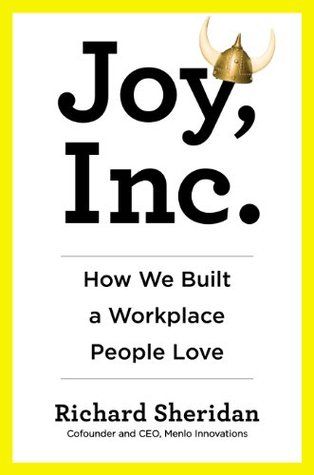Joy Inc
Life is too short. Don't spend most of your life working in a job you hate. It doesn't have to be that way. This book will show you how to introduce joy at work.

Fabiola was the first person to mention this book to me. She remarked on how simple the system for task tracking discussed in the book was. She made some kind of remark along the lines of "If they can manage with post-it notes, maybe we don't need all these fancy issue tracking and planning tools." That sparked my interest. If Fab likes it, well it must be worth checking out. That and the title definitely caught my attention. Who doesn't want to love their work? You spend so much time at work every day, so why not enjoy it?
The book describes the culture and way of working of a particular software company, called Menlo Innovations. They've been voted the best place to work in Minnesota several times. The author, who is also the owner of the business, describes how it all works and what makes it such a great place to work. It's not meant to be a follow-this-blueprint-to-nirvana kind of guide but lays out their guiding philosophy and some specific practices they observe that implement that philosophy. It's more of a "this is what is possible - and here's how we did it" kind of book. The author points out that the principles of how to achieve joy at work are pretty universal, but the practices can and should vary from one business to another.
Agility
A large part of the book describes how Menlo Innovations organizes its work. The description of the way they work is all about pair programming, story cards, kanban boards, iterations, close collaboration with customers, etc. The book talks a lot about them trying new things and experimenting and learning. The book doesn't really use the word agile, but it is all about agility and XP practices. In fact, the whole book reminds me of the agile manifesto in that it is all about principles and ideas. There are some specific practices mentioned, but they are mostly there to illustrate how Menlo Innovations implements the principles.
The Simplest Thing That Could Possibly Work
If you've read my post on Maxims to Code by, that phrase will seem familiar. I'm a big believer in software engineers' ability to over-complicate things. It's our nature and we have to constantly fight it. The answer to every problem is always "Well I could write some software to do that." Sometimes that is necessary and does help, but sometimes it gets in the way. As Fab remarked, the system used by Menlo Innovations is quite simple. There are no fancy tools, no Gantt charts, no Jira, just post-it notes on a board. It serves as a good example that being agile doesn't require a bunch of tools and fancy frameworks. It is a mindset.
Joyful Workers Work Harder
If you are looking for a business reason to implement the ideas in this book, here it is: One of the basic premises of the book is that if you treat people better and their work brings them joy, they will work harder and produce higher quality work. If you metaphorically whip people as hard as you possibly can, in a misguided attempt to eek as much performance out of them as possible, they will do just enough not to get fired. Worse, the good ones will leave and you'll be left with ones who are incapable of finding a better job. It's a really simple idea, I just don't get why corporate 'Merica ignores it.
Remote Work?
The one issue I would take with the book is that he is very bearish on remote work. In true agile fashion, he does mention that they've done some experiments and it just didn't work out for them. I am very bullish on remote work. I think it is the wave of the future (yes even in the LabVIEW world - sometimes you are required to be onsite and there is a often lot that can be done remotely). The author does make some good points about in-person work. There is a certain energy and spirit that comes from sharing physical space that is hard to recreate digitally. I think it is possible, but it is hard and requires effort (and some tools - maybe not the simplest thing that could possibly work). I will give the author and Menlo Innovations some credit in that they do allow remote work for certain temporary situations when needed. This book was written before the pandemic. I'd be very interested to hear the author's current views in light of the pandemic.
Everyone Should Read This Book
I think this is a book for everyone. It's centered around a software business, but the ideas are universal. If you run a business, it's a great resource for ideas on how to add more joy to your workplace. Similarly, if you are a manager. If you are an employee, then it is an inspiration to either change where you work or change where you work. It shows you what is possible. Life is too short. Don't spend most of your life working in a job you hate. It doesn't have to be that way.